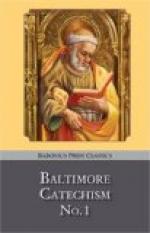Protestants and others say that Catholics break the First Commandment by having images in their churches, because the First Commandment says: “Thou shalt not make graven images or the likeness of anything upon the earth,” etc. Now, if that is exactly what the Commandment means, then they break it also, because they make the images of generals, statesmen, writers, etc., and place them in their parks. They also take photographs of their relatives and friends and hang them on the walls of their homes. They do this, they say, and we believe them, to show their respect and veneration for the persons represented, and not to worship their images. Now we do no more. We simply place in our churches the images of saints to show our respect and veneration for the persons they represent, and not to worship the images themselves. So if we break the First Commandment, they who make any picture or statue break it also. Can our accusers not see that they and every citizen do the very thing for which they reproach us? On Decoration Day they place flowers around the statue of Washington and other great men. Does anyone believe that they are trying to honor the piece of metal or stone, or that the metal or stone statue knows that it is being honored? Certainly not. They do so to honor Washington or whomsoever the statue represents; and for the same reason Catholics place flowers and lights around the statues and images of saints. Every child knows that the wood in the statue might as well have been a pillar in the Church, and that its selection for a statue was merely accidental, and hence he knows that the statue cannot hear or see him, and so he prays not to the statue but to the person it represents. Again if you can offer a person insult by dishonoring his image, may we not honor him by treating it with respect? What greater insult, for instance, could be offered to your deceased father and yourself than to burn him in effigy, or contemptuously trample his picture under foot in your presence? Thus they who treat the images of Christ or His saints with disrespect dishonor Christ and His saints.
Again we may learn our religion by our sight as well as by our hearing, and may be led by these visible objects to a knowledge of the invisible things they represent. Let us take an example. A poor ignorant man enters a Catholic church, and sees hanging there a picture of St. Vincent de Paul. He can learn the life of the saint from that picture almost as well as if he read it in a book. He sees the saint dressed in a cassock, and that tells him St. Vincent was a priest. He sees him surrounded by little ragged children and holding some of them in his arms; that tells him the saint took care of poor children and orphans, and founded homes and asylums for them. He sees on the saint’s table a human skull, and that tells him St. Vincent frequently meditated upon death and what follows it. He sees beside the skull a little lash or whip, and that




